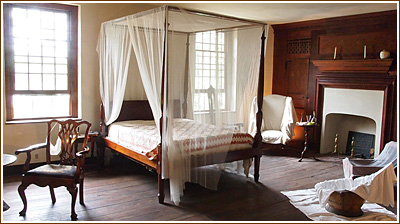'DRESSING' AN 18TH-CENTURY CAMDEN
MANSION FOR SUMMER
Keeping Cool and Battling Glue-Eating Bugs
Photos by Hoag Levins

CAMDEN, N.J. -- Chandeliers, gilded picture frames and mirrors were among a wealthy 18th-century family's most valuable and prestigious possessions. But the gilding process of that era used a glue made from rabbit hide that drew swarms of hungry summer flies. So, families like the Coopers in Camden's Pomona hall greeted summer by draping their mirrors, picture frames and chandeliers in an open-weave gauze to protect them from hungry bugs and the corrosive droppings the insects left behind. Click photos for larger image
|
|

|
|
'Summer dress' was a seasonal 18th-century housekeeping practice that also used gauze netting to protect family members throughout the mansion that lacked window screens. The overall 'summer dress' practice resulted in dramatic changes in decor all designed to help family members stay cool and comfortable in southern New Jersey's steamy summer months. Here, in Pomona Hall's master bed chamber, the heavy tapestry-like bed curtains of winter have been replaced by airy gauze netting. |
|

|
|
The main bed chamber of Pomona Hall was also where mother and grandmother may have tended young children and took their own rare full-body washings in an even rarer metal bathtub that was a further mark of their wealth and status. Mosquito netting protects the cradle, while white sheets line the tub.
|
|

|
|
Before air conditioners, electric fans and window screens, most activities of daily life at colonial mansions like the Cooper's moved into the spacious center hallway, with its front and back doors thrown open to take full advantage of cross ventilation and summer breezes. Cool, light-colored slipcovers or throws protected expensive wool damask-upholstered furniture. (The far door originally opened to the outside air. The front door is directly behind the camera.) |
|

|
|
In a colonial New Jersey landscape close to the Delaware River and its networks of creeks and swamps meandering through dense forests, the battle against insects was never-ending for families like the Coopers. Along with the mosquito and fly netting that so changed the interior of Pomona Hall, the Coopers used glass flycatchers baited with sugar water to lure pesky bugs to their death. |
|

|
|
Aside from the ferocious heat of the open-hearth kitchen where they worked to feed as many as two dozen people daily, the slaves and indentured servants of Pomona Hall were plagued by bugs in the summer. Here, in the kitchen, gauze netting was a crucial tool for keeping hungry insect swarms off the foods. |
|
All Rights Reserved, © 2013 HistoricCamdenCounty.com
Contact: editor@HistoricCamdenCounty.com
About this Web site
|
|
|

